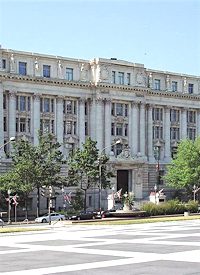
The Washington, D.C., school system ranks among the worst in the country, despite spending a lofty $18,000 per student. According to Texas Congressman and Republican presidential candidate Ron Paul, the federal government has sunk an astronomical amount of money into the system, and it has only intensified the crime and educational deficiencies in D.C. public schools. Therefore, Dr. Paul recommends a bold solution: Abolish the Department of Education.
Speaking at a town hall meeting in Idaho on Monday, Paul observed:
The federal government … has one responsibility in education, and that is over the city of D.C. So why shouldn’t the American people look at the example, look at the ability of the federal government to deal with an educational system. It’s probably the worst one in the country, unfortunately.
I mean it has more crime. It has more drugs, a terrible educational system and very expensive. And every year, the people from the city come to the Congress [requesting more funding]. And inevitably, they get more money. So they’re up to about $18,000 per student.
According to some statistics, homeschooling parents pay about $550 per year to educate their child; by comparison, taxpayers pay on average more than $10,000 per student in the public education system.
“And guess what? If you’re a home schooler or if you have a private school, you don’t have to ask the government whether or not you can say a prayer or read the Bible. You have the right to do that,” Paul asserted. “Then they say, ‘Well, maybe they won’t get as good of an education.’ Well I think that’s been disproven. I think people who get private education or home schooling do quite well.”
So does spending 95 percent less to educate children mean they are receiving an inferior education? According to a nationwide study — the most comprehensive survey on U.S. homeschoolers in over a decade — orchestrated by Dr. Brian Ray of the National Home Education Research Institute, this is not the case. In fact, Dr. Ray’s conclusions show quite the contrary.
In the study, homeschoolers were found to have scored 34 to 39 percentile points higher on standardized achievement tests than students in private and public schools. The national average for homeschool students ranged from the 84th percentile for math, language, and social studies to the 89th percentile for reading.
By some estimates, it costs about half as much to educate a student in a private school as in a public school. And, again, the reduced cost of educating the private-school student does not reflect adversely on the student’s test scores. Similar to Dr. Ray’s conclusions, in a 2009 analysis, the National Center for Education Statistics found quite the contrary. In grades four and eight for both math and science, students in private schools performed at significantly higher levels than students in public schools:
&bull: Grade four private-school students scored 8 percentage points higher than public-school students in basic math.
&bull: Grade eight private-school students scored 14 percentage points higher than public-school students in basic math.
&bull: Grade four private-school students scored 15 percentage points higher than public-school students in basic reading.
&bull: Grade eight private-school students scored 18 percentage points higher than public-school students in basic reading.
But still, under President Obama’s 2013 budget proposal, he is choosing the $18,000 cost over the $8,000 per-student expenditure of granting a private-school voucher to a child under the D.C. Opportunity Scholarship Program (OSP). Moreover, if the President’s proposal is enacted, the Department of Education’s budget will be boosted by 3.5 percent.
As the data indicate, those D.C. students who received private-school vouchers delivered astounding results, as the Heritage Foundation reported:
The D.C. OSP has been highly successful. According to federally-mandated evaluations of the program, student achievement has increased, and graduation rates of voucher students have increased significantly. While graduation rates in D.C. Public Schools hover around 55 percent, students who used a voucher to attend private school had a 91 percent graduation rate. …
By contrast, the D.C. OSP has a stellar track record of increasing academic success, student safety, and parental satisfaction. And because of the nature of the District of Columbia (education in D.C. is under the jurisdiction of Congress), it is entirely appropriate for the federal government to fund the D.C. OSP.
Under the same budget plan, Obama proposed to hike taxpayer-funded subsidies for consumers purchasing energy-efficient vehicles — including the Chevy Volt — to $10,000 per buyer, up from $7,500. As Heritage indicated in a blog post last month, the President clearly favors rich yuppies who can afford a $41,000 vehicle over poverty-stricken children floundering in poor D.C. schools:
Want a clear indication of President Barack Obama’s priorities? Take a look at the spending decisions emerging from his Administration today. In the battle between $40,000 dollar-electric-car-buying yuppies and at-risk kids in the DC Opportunity Scholarship Program, rich people won, and they have President Obama to thank for it.
All in all, the President seems more concerned with further augmenting a government-monopolized education system than providing choices for children suffering under poor education environments. And according to the President’s motives, igniting an overall shift from public to private education — the ideal move — is certainly out of the question.
Endless sums of data prove this point: It does not take $18,000 — or even $10,000, for that matter — to educate a child. Shifting education from government to private hands will boost academic achievement and tame the mounting tax burden for American workers.
And as Congressman Paul points out, abolishing the Department of Education is the first step in this process.
Photo: The John A. Wilson Building, which houses the offices of the mayor and council of the District of Columbia.



